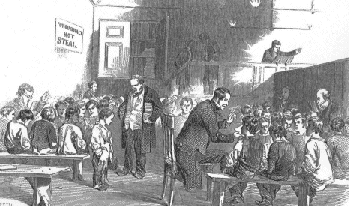Since the establishment of the national school system, boys and girls now received the same education including learning how to sew and knit. In the smaller schools, the classes were mixed, both boys and girls right through what is known as Standard 7. In the larger ones, the boys were usually moved in separate classes at Standard 2.
 In the 1890s, boys were mandated to learn drawing and military drilling while girls were taught sewing. Instead of learning Latin or mechanics, the girls were often taught laundry skills and cooking. Parents and teachers alike protested this, but nothing came of it outside of the girls not showing up for the classes.
In the 1890s, boys were mandated to learn drawing and military drilling while girls were taught sewing. Instead of learning Latin or mechanics, the girls were often taught laundry skills and cooking. Parents and teachers alike protested this, but nothing came of it outside of the girls not showing up for the classes.
The education boys received continued to differ significantly from that received by the girls. Truancy among boys was more severely punished as it was still felt that girls would marry and the education go to waste. At that time, the majority of parents had no problem with domestics being taught to their daughters.3
A small group of poor students were made monitors and eventually pupil-teachers. They received minimal pay, continued to live at home and generally came from the working class. They worked at the school all day and studied their advanced subjects either before classes began or after they ended as well on Saturdays. Upon reaching the age of 18, they took an exam called the queen's scholarship and if they passed went on to further their education as a teacher.
Scholarships were available to grammar school as well as universities. The odds of a poor child receiving a scholarship to grammar school was about 40 to 1 and even if offered usually was unable to accept it. Many in fact had to leave school sooner due to the economic hardships faced by their families.4
Going to school was the Victorian child's first experience into the "social" world. Many went with anxiety with the fear of ridicule due to their lack and/or quality of clothing. Some in fact chose not to go on a regular basis. Jack Lanigan in 1890 had to wear sacks on his feet for shoes. He went to a ragged school where all the children fit the name perfectly. "You never saw such a bunch of scruffy kids in all your life. If we had been bunched together you could not have made a suit from the lot."5
Sensitivity was not a strong point during the period. The students that fared the worse were the workhouse and illegitimate children. Laws were passed to provide these children with free meals and health-care screenings for which the children were mocked even more. The teachers themselves called these children names such as "the dirty girls".6
Still there were others who's education was a positive event in their lives and in fact who developed a love of learning. Regardless of its weaknesses or flaws, the educational system did achieve basic literacy by 1900.
-
Davin, Growing Up Poor, 143-147; Jane McDemid, Schooling of Working Class Girls in Scotland (London: Routledge, 2005) 91-94.
Burnett, Destiny Obscure, 159, 175-180; Anderson, Education and Opportunity, 152-153; McDermid, Schooling of Working Class Girls, 114-142.
Burnett, Destiny Obscure, 88.
Burnett, Destin Obscure,, 2003-205; Littler, Victorian Chldhood, 33-34; Horn, Victorian Town Child, 165.
|
|
|
|
Back to Intro/Index or Site Map
| | Family Gallery | Servants Parlour | Tour Home | Typical Day | Etiquette | Shopping Trip | |
| | Victorian Christmas | Victorian England Fun and Games | Ashton Library | Victorian Wedding | |
| | Victorian England Overview | Guest Registry | Honorary Victorian | Tours | |
| | Awards Received | Bibliography | |
| | 1876 Victorian England Home | |
Credits below copyright information |
| Contact
webmaster |
| Copyright
1999-2017 All Rights Reserved - B. Malheiro May not be reproduced in any way without express written permission of webmaster. |
Credits:
Background and buttons are the creation of webmaster, B. Malheiro. These images have been watermarked and are not for use on another site. Site authored by webmaster.